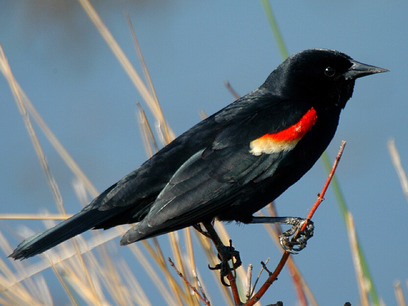 Having been a longtime early morning walker and jogger around my neighborhood between Milton Road and Forest Avenue, I start looking for winter’s departure and spring’s arrival as short-month February segues into March.
Having been a longtime early morning walker and jogger around my neighborhood between Milton Road and Forest Avenue, I start looking for winter’s departure and spring’s arrival as short-month February segues into March.
By Bill Lawyer
Having been a longtime early morning walker and jogger around my neighborhood between Milton Road and Forest Avenue, I start looking for winter’s departure and spring’s arrival as short-month February segues into March.
But when I was out walking those first few mornings of March, I was reminded of that famous Sherlock Holmes “curious” mystery story about a horse and a dog – the dog that didn’t bark.
And I thought to myself as I walked across the Milton Cemetery footbridge, “What’s missing here?”
And then it hit me – where were the red-winged blackbirds?
Just to put it in perspective, over the last few days of February I saw plenty of wildlife, on a daily basis. Along Crescent Avenue and Thorne Place on the west side of Disbrow, I saw seen deer so at home that I expected them to offer me a bottle of water or an energy bar as I jogged by.
 Walking across the cemetery footbridge I watched a great blue heron stalking its morning breakfast. I heard and saw one or more belted kingfisher flitting from branch to bush, getting ready to swoop down into the brook.
Walking across the cemetery footbridge I watched a great blue heron stalking its morning breakfast. I heard and saw one or more belted kingfisher flitting from branch to bush, getting ready to swoop down into the brook.
I heard the gurgling sound of red-bellied woodpeckers feeding and looking for nesting sites, the cheerful call of cardinals, and the long, whistling call of chickadees.
I smelled the burning smells of skunks on Rye Beach, Elmwood, and Oakwood — but luckily didn’t encounter any up-close and personal.”
And, of course, I saw the large flocks of mallard ducks and Canada geese as they “commuted” from the brook to the ball fields on their daily feeding and “pooping” forays. As February progressed, there did seem to be more than our usual year-round waterfowl – perhaps due to some migrators passing through.
Along with all these wildlife creatures, starting in mid-February I’ve seen the green shoots of daffodils pushing their way up from the ground along Forest and Dearborn Avenues by Rye Town Park.
Despite the big snow of early February, the winter aconite (Eranthis) in my backyard was glowing in the sunshine on cold, clear winter days.
But where were the red-winged blackbirds? Over the years that I’ve been ambulating early, the redwings have always arrived by mid-February. You can’t miss them, as they arrive in large flocks and settle in along the brook, making all kinds of noisy calls and songs. And they’re obviously busy setting up shop for the breeding season. I could stand on the footbridge and watch them from just a couple of feet away – that’s how oblivious they are. In fact, I think they’ve been taking lessons from the deer.
But this year, it was only on March 10 that the marshy area was beginning to jitter and flitter with flashes of red and orange color.
Out of curiosity, I contacted the Journey North organization, which coordinates field research and study of wildlife migrations. On their website, they have a list of the weekly sightings of various species, including redwings, starting in early February. And sure enough, most of the sightings for our area have been since the beginning of March.
So I guess the question would be – why? And while it’s premature for a definitive answer, one factor has to be the weather. This year, February’s average temperature was three degrees lower than normal. Most migratory birds tend to work their way north gradually, taking advantage of the warm, southerly winds.
And as we all know, this has been the winter of the named and no-named nor’easters.
But, hopefully, things are looking up for a spring filled with birdsong, right in our backyards.















